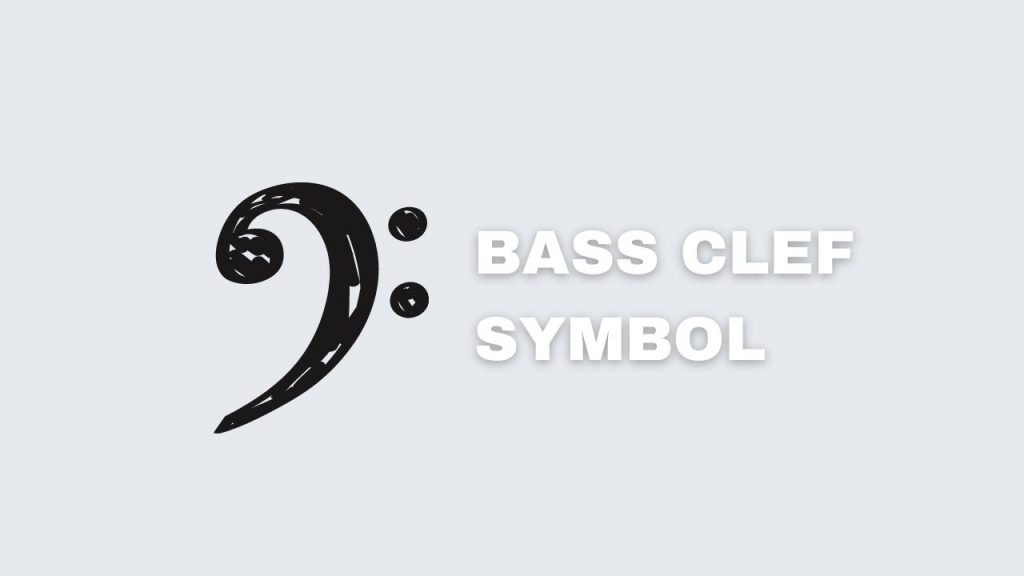The bass clef, otherwise known as the F clef, directs the player to play the note lower on the staff. In this article, we will discuss what bass clef is, why it exists, and what instrument reads this type of clef. We’ve also included tips about bass clef identification and how to remember it.
What Is It?

It is a symbol that looks like the letter “F” with two dots. The symbol sits on the second line of treble clef staff, also referred to as the G-clef sign. It has only one note, so there are no additional dots or notes after the clef sign itself. Some students mistakenly believe that the note after the G-clef sign is F, but that would be incorrect.
Why Does the Bass Clef Exist?
Using a bass clef is a convenient way to show a melody on two staves.
This type of clef allowed composers to add harmony by writing in different voices above or below the main melody line on the grand staff. For instance, organists could play low notes better than any other instrument player at this time. It was not until later that composers started using it for all instruments in symphony orchestras because it could be seen easier from further away.
What Instrument Reads the Bass Clef?
String instruments (bass guitar, cello, double bass, viola, and violin) reads this clef.
However, you would not be able to play it on a cello or violin unless you either learned bass clef fingerings or just played it as the treble clef.
To play it correctly, you would have to have a double-bass, an upright electric bass guitar, or an electric contrabass guitar with a low “B” tuned down one octave from the standard “B” just above middle “C.”
How Do You Identify the Bass Clef?
To identify where your cleft is on your instrument, you can either memorize where it is or if that does not work for you, use this step-by-step process:
- Locate the G-clef sign found on either the third or fifth line of the staff, depending on what key signature is in use at the beginning of the piece. To determine which one it is, look at the key signature. If there are keys designated with flats (♭), then it will be the third line of the staff. If there are no flats, it will be the fifth line of the staff.
- Follow the two dots in the middle of G-clef forward.
- The note on either second or fourth space (called ‘space’ because it is between lines) after you finish following the dots in the G-clef sign will be your low E string (on an instrument like a violin). That is your lowest pitch; therefore, that’s your Bass Cleft! For example, if a piece starts with an F key signature and has D as its lowest note, then this would mean that there is a bass clef sitting at the sixth line of treble clef’s staff.
How Do You Remember Bass Clef Notes?
One way to remember its notes is to associate the F with the line placed on it and then think of an imaginary or real person whose name starts with ‘F.’
You could say that this name has a low note in its range, such as Fred, Farley, Finley, or Flo. The next step would be to pick one name and associate it with the low notes found in the clef. From there, you can picture your F person playing those low notes and use them as memory cues for each note on the staff.
Another way to identify and memorize clef notes is by using solfege – Do, Re, Mi, Fa, So, La, Ti (Do).
If the low note is on ‘Do,’ visualize yourself doing something that starts with an F, like fishing or having fun. Another option would be to identify the clef notes by their location on your instrument.
The lines of the staff represent different strings or keys on your instrument, and you could imagine playing them as if they were open strings (strings played without fingers pressing down on any frets).
For instance, if you placed your right hand over a piano keyboard to cover all white keys and then start at the bottom left key and read up each line to the top of middle C, you would play E-G-B-D-F-A. Since they are all open strings, you can remember them by the phrase “every good boy does fine.”
Conclusion
Bass clef is the lowest sounding clef of the four. Composers first used it for instrumental parts, and later it became a common signifier of an instrument’s lowest register. Some ways to identify and remember clef notes are: associating F with the line on which it sits, using solfege – Do, Re, Mi, Fa, So, La, Ti (Do), identifying the notes by their location on your instrument, and visualizing yourself doing something that starts with an F like fishing or having fun.
Table of Contents






